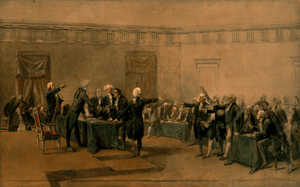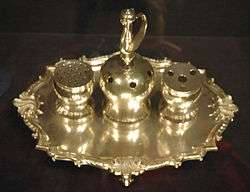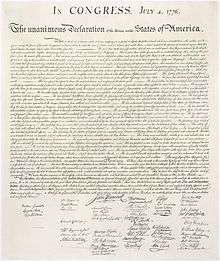Signing of the United States Declaration of Independence

The signing of the United States Declaration of Independence occurred following its July 4,1776 approval by 56 delegates to the Second Continental Congress meeting in Philadelphia, Pennsylvania. The declaration proclaimed that the thirteen American colonies then at war with Great Britain were now sovereign states, and thus no longer a part of the British Empire. Although the wording of the Declaration was approved by Congress on July 4, the date of its signing has been disputed. Most historians have concluded that it was signed nearly a month after its adoption, on August 2, 1776, and not on July 4 as is commonly believed.
Date of signing

The date that the Declaration was signed has long been the subject of debate. Within a decade after the event, Thomas Jefferson, Benjamin Franklin, and John Adams all wrote that the Declaration had been signed by Congress on July 4, 1776.[1] This seemed to be confirmed by the signed copy of the Declaration, which is dated July 4. Additional support was provided by the Journals of Congress, the official public record of the Continental Congress. When the proceedings for 1776 were first published in 1777, the entry for July 4, 1776, stated that the Declaration was engrossed (the official copy was handwritten) and signed on that date.[2]
In 1796, signer Thomas McKean disputed that the Declaration had been signed on July 4, pointing out that some signers were not then present, including several who were not even elected to Congress until after that date.[3] "[N]o person signed it on that day nor for many days after", he later wrote.[4] Although Jefferson and Adams disagreed with McKean, his claim gained support when the Secret Journals of Congress were published in 1821.[5] The Secret Journals contained two previously unpublished entries about the Declaration. The entry for July 19 reads:
Resolved That the Declaration passed on the 4th be fairly engrossed on parchment with the title and stile of "The unanimous declaration of the thirteen united states of America" & that the same when engrossed be signed by every member of Congress.[6]
The entry for August 2 stated:
The declaration of Independence being engrossed & compared at the table was signed by the Members.[7]

In 1884, historian Mellen Chamberlain argued that these entries indicated that the famous signed version of the Declaration had been created following the July 19 resolution, and had not been signed by Congress until August 2.[8] Historian John Hazelton confirmed in 1906 that many of the signers had not been present in Congress on July 4, that the fifty-six signers had never been together as a group, and that some delegates must have added their signatures even after August 2.[9] While it is possible that Congress signed a document on July 4 that has since been lost, historians do not think that this is likely.[10]
Although most historians have accepted the argument that the Declaration was not signed on July 4, and that the engrossed copy was not created until after July 19, legal historian Wilfred Ritz wrote in 1986 that "the historians and scholars are wrong".[11] Ritz argued that the engrossed copy of the Declaration was signed by Congress on July 4, as Jefferson, Adams, and Franklin had stated, and that it was implausible that all three men had been mistaken.[12] Ritz believed that McKean's testimony was questionable,[13] and that historians had misinterpreted the July 19 resolution. According to Ritz, this resolution did not call for a new document to be created, but rather for the existing one to be given a new title, which was necessary after New York had joined the other twelve states in declaring independence. Ritz argued that the phrase "signed by every member of Congress" in the July 19 resolution meant that delegates who had not signed the Declaration on the 4th were now required to do so.[14]
Ritz argued that about thirty-four delegates signed the Declaration on July 4, and that the others signed on or after August 2.[15] Historians who reject a July 4 signing maintain that most delegates signed on August 2, and that those eventual signers who were not present added their names later.[16]
List of signers
Fifty-six delegates eventually signed the Declaration:
Signer details
Of the approximately fifty delegates who are thought to have been present in Congress during the voting on independence in early July 1776,[17] eight never signed the Declaration: John Alsop, George Clinton, John Dickinson, Charles Humphreys, Robert R. Livingston, John Rogers, Thomas Willing, and Henry Wisner.[18] Clinton, Livingston, and Wisner were attending to duties away from Congress when the signing took place. Willing and Humphreys, who voted against the resolution of independence, were replaced in the Pennsylvania delegation before the August 2 signing. Rogers had voted for the resolution of independence but was no longer a delegate on August 2. Alsop, who favored reconciliation with Great Britain, resigned rather than add his name to the document.[19] Dickinson refused to sign, believing the Declaration premature, but remained in Congress. Although George Read had voted against the resolution of independence, and Robert Morris had abstained, they both signed the Declaration.
The most famous signature on the engrossed copy is that of John Hancock, who, as President of Congress, presumably signed first.[20] Hancock's large, flamboyant signature became iconic, and John Hancock emerged in the United States as an informal synonym for "signature".[21] Two future presidents, Thomas Jefferson and John Adams, were among the signatories. Edward Rutledge (age 26) was the youngest signer, and Benjamin Franklin (age 70) was the oldest signer.

Some delegates, including Samuel Chase, were away on business when the Declaration was debated, but were back in Congress to sign on August 2. Other delegates were present when the Declaration was debated but added their names after August 2, including Elbridge Gerry, Lewis Morris, Oliver Wolcott, and Thomas McKean. Richard Henry Lee and George Wythe were in Virginia during July and August, but returned to Congress and signed the Declaration probably in September and October, respectively.[23]
As new delegates joined the Congress, they were also allowed to sign. Eight men signed the Declaration who did not take seats in Congress until after July 4: Matthew Thornton, William Williams, Benjamin Rush, George Clymer, James Smith, George Taylor, George Ross, and Charles Carroll of Carrollton.[24] Because of a lack of space, Thornton was unable to sign next to the other New Hampshire delegates; he instead placed his signature at the end of the document, on the lower right.[25]
The first published version of the Declaration, the Dunlap broadside, did not list the signers except for those of John Hancock and Charles Thomson. The public did not learn who had signed the engrossed copy until January 18, 1777, when the Congress ordered that an "authenticated copy", including the names of the signers, be sent to each of the thirteen states.[26] This copy, the Goddard Broadside, was the first to list all the signers.[27]
Stories and legends
Various legends about the signing of the Declaration emerged years later, when the document had become an important national symbol. In one famous story, John Hancock supposedly said that Congress, having signed the Declaration, must now "all hang together", and Benjamin Franklin replied: "Yes, we must indeed all hang together, or most assuredly we shall all hang separately." The quote did not appear in print until more than fifty years after Franklin's death.[28]
Notes
- ↑ Warren, "Fourth of July Myths", pp. 242–43
- ↑ Warren, "Fourth of July Myths", p. 246; Burnett, Continental Congress, p. 192
- ↑ Hazelton, Declaration History, pp. 299–302; Burnett, Continental Congress, p. 192
- ↑ Hazelton, Declaration History, p. 302
- ↑ Warren, "Fourth of July Myths", pp. 243–45
- ↑ U.S. Continental Congress, Secret Journals vol. 1, p. 46
- ↑ U.S. Continental Congress, Secret Journals vol. 1, p. 46
- ↑ Warren, "Fourth of July Myths", pp. 245–46
- ↑ Hazelton, Declaration History, pp. 208–19; Wills, Inventing America, p. 341
- ↑ Maier, American Scripture, p. 150; Warren, "Fourth of July Myths", p. 242. Boyd (Papers of Jefferson, 1:306–08) believed that, despite historical consensus to the contrary, an informal signing on July 4, followed by a formal signing on August 2, was at least "plausible". Wills (Inventing America, pp. 342–43) called Boyd's reasoning "farfetched", arguing that a July 4 signing "makes no sense".
- ↑ Ritz, "Authentication", p. 179
- ↑ Ritz, "Authentication", p. 182
- ↑ Ritz, "Authentication", pp. 198–200
- ↑ Ritz, "Authentication", pp. 190–200
- ↑ Ritz, "Authentication", p. 194
- ↑ Hazelton, Declaration History, pp. 208–19
- ↑ Friedenwald (Interpretation and Analysis, p. 143) says that 45 delegates can be confirmed present on July 4, and that another four might have been.
- ↑ Friedenwald (Interpretation, p. 149) gives the number of non-signers as seven, not counting Dickinson, who absented himself for the final votes.
- ↑ Hazelton, Declaration History, pp. 525–26
- ↑ Hazelton, Declaration History, p. 209
- ↑ Merriam-Webster online; Dictionary.com.
- ↑ Malone, Story of the Declaration, p. 90
- ↑ Friedenwald, Interpretation, p, 148
- ↑ Friedenwald (Interpretation, p. 149) lists seven men; he does not include Charles Carroll of Carrollton, but although Carroll had been working as an emissary for Congress, he did not become an official member of the Maryland delegation until July 4, and did not take his seat as a delegate until July 18; Hazelton, Declaration History, pp. 529, 587
- ↑ Friedenwald, Interpretation, p. 150
- ↑ Warren, "Fourth of July Myths", p. 247; Hazelton, Declaration History, p. 284; Friedenwald, Interpretation, p. 137, where the date is misprinted as January 8, but correct on page 150.
- ↑ Friedenwald, Interpretation, p. 137
- ↑ Malone, Story of the Declaration, p. 91
References
- Boyd, Julian P., ed. The Papers of Thomas Jefferson, vol. 1. Princeton University Press, 1950.
- Boyd, Julian P. "The Declaration of Independence: The Mystery of the Lost Original". Pennsylvania Magazine of History and Biography 100, number 4 (October 1976), 438–67.
- Burnett, Edward Cody. The Continental Congress. New York: Norton, 1941.
- Friedenwald, Herbert. The Declaration of Independence: An Interpretation and an Analysis. New York: Macmillan, 1904. Accessed via the Internet Archive.
- Hazelton, John H. The Declaration of Independence: Its History. Originally published 1906. New York: Da Capo Press, 1970. ISBN 0-306-71987-8. 1906 printing available on Google Book Search
- Maier, Pauline. American Scripture: Making the Declaration of Independence. New York: Knopf, 1997. ISBN 0-679-45492-6.
- Malone, Dumas. The Story of the Declaration of Independence. New York: Oxford University Press, 1975. A picture book with text by a leading Jefferson scholar.
- Ritz, Wilfred J. "The Authentication of the Engrossed Declaration of Independence on July 4, 1776". Law and History Review 4, no. 1 (Spring 1986): 179–204.
- United States Continental Congress. Secret journals of the acts and proceedings of Congress, from the first meeting thereof to the dissolution of the Confederation, vol. 1, p. 46. Boston: Thomas B. Wait, 1820.
- Warren, Charles. "Fourth of July Myths." The William and Mary Quarterly, Third Series, vol. 2, no. 3 (July 1945): 238–72.
- Wills, Garry. Inventing America: Jefferson's Declaration of Independence. Garden City, New York: Doubleday, 1978. ISBN 0-385-08976-7.
